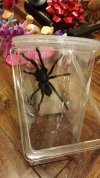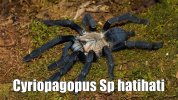- Messages
- 11
My sister bought me a young female Borneo Black for Christmas. I think shes great, the people at the shop told her it was a Black Velvet, but she is 100% a borneo black.
Ive had easier, social, tarantulas like Rose haired in the past, and the behavior of this spiderling is very different- so i had a question-
She has made a burrow (aboreal, yes, but the young burrow) and built a door blocking the entrance. She hasnt come out to eat or drink in 5 days. Is it the shock of moving around, and changing enclosures?
I just want to make sure my babes okay :/
Ive had easier, social, tarantulas like Rose haired in the past, and the behavior of this spiderling is very different- so i had a question-
She has made a burrow (aboreal, yes, but the young burrow) and built a door blocking the entrance. She hasnt come out to eat or drink in 5 days. Is it the shock of moving around, and changing enclosures?
I just want to make sure my babes okay :/





